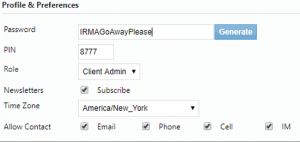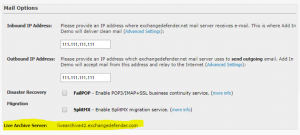Some tips on getting ready for a disaster with ExchangeDefender
I held a quick webinar to get all of our partners and clients in the way of Hurricane Irma up to speed and all the contingencies you need to make in advance of the storm. In Florida and Texas we unfortunately get plenty of time to practice and live roll with disasters but if you have new staff, this is something you need to be doing with your clients continuously. If you don’t feel like watching a 12 minute video, here is a brief writeup.
First of all: We’ll be here. 24/7. If you’re in the path of the storm you will likely face severe outages, downtime, lack of reception, eventual lack of battery power and network congestion in a disaster area. Here are things to keep in mind and get on top of as far as we are concerned.
In the event our support portal ever goes offline, the secondary infrastructure in Los Angeles will pick up the load at:
https://support2.ownwebnow.com
In the event of an outage, we probably aren’t the only vendor you need to stay on top of. So if you do social media, you can track our activity and advisories here:
www.fb.com/ExchangeDefender
www.twitter.com/xdnoc
In the event that the net goes down, and it usually does, make sure you can get in touch with us. Our numbers are 877-546-0316 or 407-465-6800
In the event that you lose network connectivity or your LTE/4G suddenly becomes Edge/GPRS, you will likely be calling us for support and network changes. We’ll need your PIN to make any account or configuration changes to make sure you and your techs have that ready now. If you haven’t seen your pin in a while or if you’d like to reset it, it’s at support.ownwebnow.com under your contact preferences.
In the event that your power goes down, Exchange/ActiveSync will chew through your battery quickly. Make sure you setup your ExchangeDefender LiveArchive IMAP/SMTP now. Make sure you test the IMAP-SSL/SMTP-SSL part in the event that your mobile carrier blocks 587. We have a few LiveArchive frontends so if you’ve only ever heard of https://livearchive.exchangedefender.com you’ll want to login into the admin portal and find out which LiveArchive client access server you should be using. Do yourself a favor and set your LiveArchive-To-Go account, it’s free and it can sit on your phone dormant, just flip it on when you need it. Not only will it use far less bandwidth than Exchange/EAS, it will make your battery last a lot longer.
Finally, print out the client auth dump. This will give you all the credentials you’ll need to provide to your clients to get them back to work if their servers or networks go offline. Trust me, you want to do this now. I have fielded countless panicked calls from IT people charging their cell phone in the trunk of their car trying to get credentials reset and configured for their clients – plan this now.
Some other ideas and suggestions:
1. Any important data that you imagine you’ll need on the go: Encrypt it and take it with you on physical media. For really important stuff like insurance, routing, VPN, etc make sure it’s printed out and you have all the relevant phone numbers.
2. Take pictures of all the gear you’re leaving behind and do a video walkthrough of the setup. Trust me, you’ll forget to take a picture of something.
3. I’d like to repeat #1: Print a hard copy of contact points, client info, anything you will need to obtain assuming both computers and networks are unavailable or batteries drained.
4. Agree on a cloud based chat system to keep in touch with your staff. This is essential.
5. Publish and announce an offside advisory site. As you start restoring services, you need to keep your clients in the loop – nothing worse than recovering from a disaster and simultaneously having to listen to someone whine or nag for an ETA that is just slowing you down. Make sure you have a Twitter or Facebook account to point them to for an update. You probably don’t want to call a thousand people back. Expect their phones to be off too because they probably have power issues as well.
6. I cannot stress this enough: Reconsider your name server infrastructure. If your DNS is provided by the same company, or if all your name servers are on the same network, subnet, etc and it goes down you are dead.
7. Setup a cloud failover crash site. If you own your own mail server, setup mailboxes just in case – if you’re going to be down for days you’ll probably want to use email in the meantime. If you’re wrong worst case scenario is you’re out a month worth of email hosting.
8. Fly someone far away. I heard Utah is beautiful and relatively hurricane-proof.
9. This one is personal: setup a remote VPN server. If all your routes, trusted networks and servers are offline you’ll have a hard time getting to the infrastructure you’re expected to manage – your clients may come back online before you do. Stand up an openvpn cloud instance with a static IP address for the time being and trust it across your network.
10. This is a bummer, and almost illegal for me to say as a Floridian, but as this is a category 5 storm it’s a really good idea to stay sober. You may be needed at a moments notice, if things get really bad you’ll really want to be aware of your surroundings and have full capacity to handle multiple outages and issues at once. Many of you are IT solution providers and someone is paying you to think about #1 – #9 I mentioned here… I’ve seen things explode well before the hurricane comes in and days after the storm passes.
Stay safe. Plan and prepare accordingly but rest assured that we’re here for you. And some of us are in Utah too. 🙂
P.S. Yes, our logo is a hurricane. Yes, we noticed 🙂



